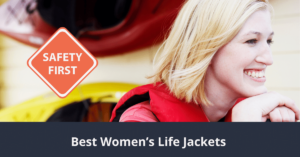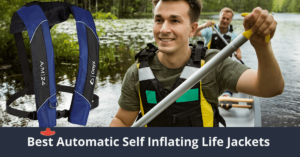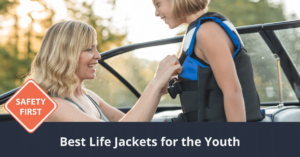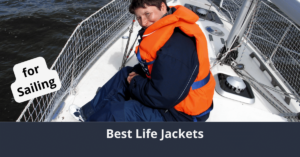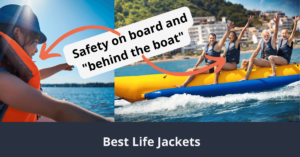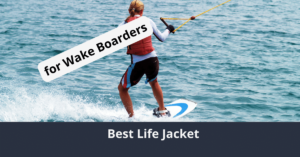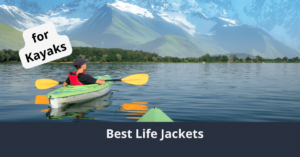For fishing enthusiasts, the water is like a second home. But, any experienced angler knows that no matter how comfortable you may be with your environment, things can go wrong in a split second. So, it’s best to stay prepared, and always wear a life jacket when you head out for a day on the lake or out to sea.
Of course, anglers have some unique needs that other people enjoying a day on the water don’t necessarily have, and this puts them at odds with most life jackets. When fishing, it simply isn’t realistic to wear something that’s bulky and restrictive, even if it can save your life. Life Jackets for fishing need to fit tightly.
Thankfully, there are plenty of quality PFDs available that are made, especially for fishers. In fact, many of these fishing-specific life vests are just as comfortable and tactical as a standard angler’s vest. Today, we’re going to take a closer look at the best fishing life jackets for 2023, and share some sage advice on how you can select the best fishing PFDs for your next trip.
(You might be interested to read our article on Best Kayak Fishing Life Jackets)
| Product Name | More Information | Sizes | Safety | Unique Features |
|---|---|---|---|---|
| ONYX Kayak Fishing Life Jacket | Sale Onyx Kayak Fishing Life Jacket, Oversize, Tan
| OVR | US Coast Guard Approved | Six adjustment straps for custom fit, Comfortable neoprene shoulder pads |
| Lixada Fly Fishing Life Vest | LIXADA Fly Fishing Vest Multi Pocket Adjustable Fishing Jacket Breathable Mesh Waistcoat Outdoor Fishing Gear for Men Women
| UNV, OVR | Polyester shell and replaceable EPE foam for superior buoyancy | Full comfort and breath ability |
| Stearns Comfort Series Collared Angler Vest | STEARNS Comfort Series Collared Angler Vest
| L, XL, XXXL | US Coast Guard Approved | Mesh shoulder panels for ventilation on breezy days |
| Onyx A/M-24 Automatic/Manual Inflatable Life Jacket | Sale Onyx A/M-24 Automatic/Manual Inflatable Life Jacket, U.S. Coast Guard Approved, Low Profile, Compact Design, Manual Convertible Inflation Option
| L, XXXL | US Coast Guard Approved | Backup valve for manual inflation if fails to inflate |
| Stohlquist Fisherman Fishing Life Jacket | Stohlquist Fisherman Lifejacket (PFD)
| M, L, XL, XXL | US Coast Guard Approved | Durable 500D ripstop shell, Plenty of specialized storage |
| NRS Chinook Fishing Life Jacket | NRS Chinook Fishing Kayak Lifejacket (PFD)
| XS, S, M, L, XL, XXL | US Coast Guard Approved | Equipped with 2 large zippered pockets, 2 accessory pockets, and 1 tool holder pocket |
| Airhead Angler Universal Paddle Vest | Airhead Unisex-Adult Yukon Angler Paddle Vest, Tan,Adult
| XL, OVR | US Coast Guard Approved, elastic strap for securing delicate tackle | Comfortable neoprene shoulder pads |
Everything you will learn here
- The Best Fishing Life Jackets (Top Picks)
- 1. Best Fishing Life Jackets: ONYX Kayak Fishing Life Jacket
- 2. Best Fishing Life Jackets: Lixada Fly Fishing Life Vest
- 3. Best Fishing Life Jackets: Stearns Comfort Series Collared Angler Vest
- 4. Best Fishing Life Jackets: Onyx A/M-24 Automatic/Manual Inflatable Life Jacket
- 5. Best Fishing Life Jackets: Stohlquist Fisherman Fishing Life Jacket
- 6. Best Fishing Life Jackets: NRS Chinook Fishing Life Jacket
- 7. Best Fishing Life Jackets: Airhead Angler Universal Paddle Vest
- Best Fishing Life Jacket Comparison Chart
- Fishing Life Jacket Buying Guide I Your Guide to Selecting the Best Product
- Wrap Up of the Best Fishing Life Jackets
The Best Fishing Life Jackets (Top Picks)
Without further ado, here are the top seven best fishing life vests on the market today.
1. Best Fishing Life Jackets: ONYX Kayak Fishing Life Jacket
- Six adjustment straps to cinch vest up for a snug fit
- High foam back accommodates high back seats
- Pockets designed for your essential gear
This vest from ONYX combines the safety you need with all of the tactical pockets and storage solutions of a traditional angler’s vest. If you’re looking for a PFD that provides an excellent range of motion and more than enough storage for a day on the water, this jacket is well worth a closer look.
This low-profile vest is made with contoured foam, so casting and paddling are as comfortable as they’d be if you were just wearing a T-shirt. The lower back is made of mesh to allow for greater airflow, and the upper back is foam to accommodate today’s high back seats.
The front of the vest provides plenty of storage for all the tools and accessories you need to have at the ready. A largemouth pocket at the left side of the vest accommodates large accessories such as radios or long-nosed pliers.
At the right side, a large pocket drops down into a fly table with the push of a button, so you can get your lures ready on the fly. There’s also a lash tab for storing small accessories, and a woven elastic section for securing other regularly used accessories.
This vest is U.S. Coast Guard approved, so you can rest assured it will keep you safe should you end up going overboard.
Pros
- Two sizes accommodate anglers with up to a 60” chest
- Six adjustment straps for a custom fit
- Plenty of storage
- U.S. Coast Guard Approved
Cons
- Zippers prone to saltwater corrosion if not rinsed after each use
- Drop-down pocket opens very quickly – precious tackle can fly overboard
- Might be too bulky for some anglers
2. Best Fishing Life Jackets: Lixada Fly Fishing Life Vest
- PREMIUM MATERIAL: Lixada fly fishing vest crafted with a premium ripstop polyester. And this vest will fit almost any person due to webbed adjustable buckle straps.If your main priority is gear storage, this fishing vest is one of a kind.
- MULTI ZIPPERED POCKETS: Our fishing jacket looks more like an outdoor vest with total 11 zippered pockets and multi attachment Ladders and accessory loops on its front and wide reflectors on the back and shoulder.
- UNIQUE DESIGN: Our fly fishing vest is designed with the modern angler in mind. It features accessory loops and attachment ladders on the chest. This unique design allows you to personalize your vest according to your fishing needs. Whether you need to attach a fly patch, a tool holder, or a tippet dispenser, these loops and ladders provide the flexibility you need.
If you’re the type of fisher, who needs tons of storage when you head out for the day, this vest from Lixada will be right up your alley.
This vest features an impressive 18 different pockets, 14 of which feature concealed zippers to protect your valuable tools and accessories. Adjustable shoulder and waist straps help you achieve a secure fit, while the sides of the vest are completely open to allow for a full range of motion.
Reflective piping along the back and shoulders of the vest ensure you’ll be visible in low-light conditions where a rescue is more challenging. The EPE foam inside this jacket is also replaceable, so you can replace the foam if needed to maintain buoyancy.
Pros
- Tons of storage
- Reflective tape at shoulders and back for increased visibility
- Full mesh back for comfort and breathability
- Available in seven different colors
Cons
- Not U.S. Coast Guard approved
- Velcro strap closures aren’t as secure as buckles
- Not for anglers above 209 pounds
3. Best Fishing Life Jackets: Stearns Comfort Series Collared Angler Vest
- US Coast Guard-approved life jacket
- Large armholes for easy casting and movement
- Large front zippered pockets to store gear and tackle-pockets also work as hand warmers
For anglers who aren’t quite as interested in bells and whistles, this PFD from Stearns may be an excellent fit for you.
This minimalistic jacket is designed for comfort and performance. The back and shoulder area is made from breathable mesh, and the arms are cut low to provide a full range of motion. A heavily padded neoprene collar keeps you comfortable throughout the day.
Two large zippered pockets on the front of the vest keep your most essential accessories and tools at the ready, and a rod loop secures your rig when you need your hands free.
Unlike most jackets which are made in universal sizes, this jacket is available in small through 3XL to provide a custom fit for every angler.
Pros
- Mesh back and shoulders for breathability and comfort
- Low cut armholes for a full range of motion
- Padded neoprene collar prevents chafing
- U.S. Coast Guard Approved
Cons
- Not much storage
- Runs small
4. Best Fishing Life Jackets: Onyx A/M-24 Automatic/Manual Inflatable Life Jacket
- U.S. COAST GUARD APPROVED: This USCG-approved Inflatable Life Jacket inflates automatically upon water immersion or manually pulling the inflation handle. Includes a back-up oral inflation tube. Approved for users 16 years or older, and over 80 lbs. Fits 30”-52” chest
- HIGHLY BUOYANT: Provides 22.5 pounds of buoyancy when fully inflated, keeping you safe and afloat. Its buoyant material offers the necessary support to keep your head above water, providing peace of mind when boating, fishing, paddling
- MANUAL INFLATION OPTION: Easily converts to MANUAL ONLY inflation mode when paddling, fly-fishing, or other activities where there is good chance you may get wet or end up in the water. Simply pull the inflation handle, providing buoyancy to keep you safely floating. Manual conversion cap included
For anglers who aren’t willing to add bulkiness to their fishing attire, the A/M-24 from Onyx could be an ideal PFD solution for you.
This life jacket features a minimalist design, but it still provides storage for a pair of sunglasses, and a backup cO2 tank, or other necessary accessories. There’s also a D-ring on the front of the jacket for securing a variety of different tools or accessories.
From a comfort perspective, it’s tough to beat the A/M-24 PFD. The jacket secures to the wearer with a single waist strap, and there’s nothing to get in your way when you’re casting or paddling a boat.
Most anglers tend to avoid automatic inflatables, as they can be prone to accidental inflation. But, this model allows you to bypass automatic operation if you prefer, which will completely prevent unwanted inflation. Or, for added safety, the vest will function automatically if you prefer. The A/M-24 also features a backup valve for manual inflation if the cO2 tank fails.
Pros
- Most comfortable option on the market
- Automatic/Manual or manual only operation
- Backup valve for manual inflation if the vest fails to inflate
- U.S. Coast Guard Approved
Cons
- Very limited storage capacity
- Prone to accidental inflation when in automatic mode
5. Best Fishing Life Jackets: Stohlquist Fisherman Fishing Life Jacket
- Stohlquist Fisherman PFD Lifejacket Gray, Large/X-Large (40in - 46in)
- High back flotation rides above the seat back of sit-on-top kayaks. Mesh lower back and open sides increase ventilation
- Graded Sizing creates a better, more appropriate fit for a wider range of users. Cross-chest cinch harness for zero ride-up
With this vest, Stohlquist manages to provide the best of both worlds, providing a vest with plenty of storage without adding too much bulk.
This vest is one of the most durable options on the market, with a 500D ripstop nylon shell where most vests employ a 200D shell. The high mesh back provides more clearance for high back seats, so it’s comfortable for most kayak anglers.
At the front, two large zipper pockets drop down into tiny tables so you can work in the field with all your tools and accessories at the ready. One front pocket features an accessory D-ring while the other provides dedicated forceps storage. The upper right side offers a multi-function lash tab for securing your rod or other tools.
From a sizing perspective, this PFD is tough to beat. Stohlquist uses graded sizing instead of offering a universal size, and cross-chest harness straps prevent the vest from riding up on you. Adjustable shoulder and waist straps allow you to dial in a truly custom fit.
Pros
- Plenty of specialized storage
- Fits better than most PFDs
- Durable 500D ripstop shell
- U.S. Coast Guard Approved
Cons
- Expensive
- Foam back may be uncomfortable in seats with very high backs
6. Best Fishing Life Jackets: NRS Chinook Fishing Life Jacket
- The Chinook is a Type III, medium profile life jacket delivering 16.5 pounds of flotation.
- PlushFit foam and a high-back design combine to create an extremely comfortable vest for any type of raft or kayak seat.
- A mesh lower-back offers added ventilation on warm days.
This jacket from NRS is another low profile option that’s ideal for anglers who are concerned with maintaining optimal mobility without sacrificing safety.
This vest features two large zippered pockets with drop-down workspaces for keeping tools at the ready as you work on your rig. There are also two smaller accessory pockets and multiple lash points for securing your rod or other tools.
This jacket is available in four different sizes to provide a more customized fit, and the patented PlushFIT foam contours to your body to provide a more custom fit over time. The vest adjusts at six different points so you can further tailor the fit once you’ve selected the right size.
Pros
- Plenty of storage
- Sleek design provides a full range of motion
- Reflective accents for visibility at night
- U.S. Coast Guard Approved
Cons
- Expensive
- Foam back may be uncomfortable in high back seats
7. Best Fishing Life Jackets: Airhead Angler Universal Paddle Vest
- Low profile foam placement
- Breathable lower back mesh
- Comfortable neoprene shoulder pads
Another great option for anglers who need tons of storage from their PFD, the Airhead Angler Universal Paddle vest, is worth a closer look.
This tactical vest offers a variety of storage solutions, including several zippered accessory pockets, lash points and even loops for securing a hydration pack so you can quench your thirst while your hands are occupied by other things.
A large drop-down pocket drops down to a large workspace for keeping your tools ready while you prepare lures for fly fishing, bass fishing, or whatever prize you’re fishing for.
This universal vest is available in regular and oversized models, and it can accommodate anyone with a chest measurement between 30-60 inches. The armholes are cut especially low to provide a full range of motion as you row or cast.
Pros
- Plenty of storage
- Dropdown workspace features an elastic strap for securing delicate tackle
- Fleece-lined hand warmer pockets
- U.S. Coast Guard Approved
Cons
- Foam back may be uncomfortable when sitting in high back seats
- Doesn’t provide as customized a fit as some other models
Best Fishing Life Jacket Comparison Chart
| Product Name | More Information | Sizes | Safety | Unique Features |
|---|---|---|---|---|
| ONYX Kayak Fishing Life Jacket | Sale Onyx Kayak Fishing Life Jacket, Oversize, Tan
| OVR | US Coast Guard Approved | Six adjustment straps for custom fit, Comfortable neoprene shoulder pads |
| Lixada Fly Fishing Life Vest | LIXADA Fly Fishing Vest Multi Pocket Adjustable Fishing Jacket Breathable Mesh Waistcoat Outdoor Fishing Gear for Men Women
| UNV, OVR | Polyester shell and replaceable EPE foam for superior buoyancy | Full comfort and breath ability |
| Stearns Comfort Series Collared Angler Vest | STEARNS Comfort Series Collared Angler Vest
| L, XL, XXXL | US Coast Guard Approved | Mesh shoulder panels for ventilation on breezy days |
| Onyx A/M-24 Automatic/Manual Inflatable Life Jacket | Sale Onyx A/M-24 Automatic/Manual Inflatable Life Jacket, U.S. Coast Guard Approved, Low Profile, Compact Design, Manual Convertible Inflation Option
| L, XXXL | US Coast Guard Approved | Backup valve for manual inflation if fails to inflate |
| Stohlquist Fisherman Fishing Life Jacket | Stohlquist Fisherman Lifejacket (PFD)
| M, L, XL, XXL | US Coast Guard Approved | Durable 500D ripstop shell, Plenty of specialized storage |
| NRS Chinook Fishing Life Jacket | NRS Chinook Fishing Kayak Lifejacket (PFD)
| XS, S, M, L, XL, XXL | US Coast Guard Approved | Equipped with 2 large zippered pockets, 2 accessory pockets, and 1 tool holder pocket |
| Airhead Angler Universal Paddle Vest | Airhead Unisex-Adult Yukon Angler Paddle Vest, Tan,Adult
| XL, OVR | US Coast Guard Approved, elastic strap for securing delicate tackle | Comfortable neoprene shoulder pads |
Fishing Life Jacket Buying Guide I Your Guide to Selecting the Best Product
We’ve just covered seven of the best fishing PFDs available today. While each of these vests is sure to make a solid choice for your next fishing trip, you’ll probably find that one (or two or three) of these vests are better suited to your needs than others.
Here, we’ll cover the different factors you’ll want to consider, as they’ll help you select the perfect fishing life jacket for your needs.
Types of PFDs
When it comes to personal floatation devices, there are many different types on the market. Each PFD is designed to address the needs of various water activities, and they fall into one of five categories:
Type I – Offshore Life Jackets
Offshore life jackets offer the most comprehensive protection of any floatation device. These vests are for use on the ocean, open seas, or remote waters. These PFDs are to be worn in situations where rescue may take hours or even days.
These PFDs are the most buoyant of any life jacket, and even if the wearer is unconscious, a Type I PFD will make them face up quickly. Offshore jackets are quite bulky, and they aren’t exceptionally comfortable. For these reasons, they’re usually only used in emergency situations.
Most boaters and fishers don’t own type I PFDs, and they’re usually reserved for commercial crafts.
Type I Specs
- Foam – 22 lbs of flotation
- Most buoyant type of PFD
- Designed for use in all water conditions and delayed rescue
- Turns unconscious wearers face-up in the water
Type II – Nearshore Buoyancy Vests
Type II vests are similar to type I, but they aren’t quite as buoyant or bulky as their open water counterparts. Manufacturers design these vests for situations where water conditions are favorable, and a quick rescue is likely.
You’ll find type II vests at practically every retailer that caters to water activities. While these vests aren’t quite as bulky, they still aren’t well suited to fishing because they restrict the full movement of your arms. So, activities like casting your rod or paddling a rowboat or kayak are out of the question when you’re wearing a type II vest.
That said, all fishermen should have type II vests on board whenever there are children on the boat, as they provide higher buoyancy than jackets designed especially for fishing.
Type II Specs
- Foam – 15.5 lbs of flotation
- Inflatable – 33.5 lbs of flotation
- For calm waters where a quick rescue is likely
- Should turn unconscious wearers face-up in the water (less effective than type I)
Type III – Floatation Aids
The type III vests are generally the sweet spot for fishers and boaters. Type III vests are for calm and open water conditions where a quick rescue is reasonably likely. They keep the wearer vertical, and from there, it’s up to the wearer to get themselves face-up and properly oriented for a rescue. Usually, this is as simple as tilting your head back.
These vests are comfortable to wear, and they don’t restrict motion, so they’re ideal for wearing when you need full use of your arms, such as when you’re casting.
Most fishers reach for a type III vest when they head out for a day on the water. But, it’s important to note that type III vests aren’t recommended for rough water conditions.
Type III Specs
- Foam – 15.5 lbs of flotation
- Inflatable – 22.5 lbs of flotation
- Lightweight and comfortable to wear
- For calm waters where a quick rescue is likely
- The wearer must orient themselves to face-up position
Type IV – Floatation Devices
Type IV PFDs aren’t actually vests, but floatation devices meant to be thrown to a conscious person who has gone overboard to support them and keep them afloat as they await a quick rescue.
Type IV PFDs are a supplement to a life vest. On their own, they won’t be able to help an unconscious person or someone who can’t swim. But, it’s still a good idea to keep a few of these on board, especially since they’re usually so small and easy to pack.
Type IV Specs
- 16-20 lbs of floatation
- Made for calm waters where a quick rescue is guaranteed
- Used as a supplement to a life jacket – not for wearing
Type V – Special Use Devices
Type V devices are a unique category of PFD, as each type V device is designed for a specific aquatic activity, such as kayaking or windsurfing. Type V PFDs must be worn exactly as described on the jacket’s label to be effective.
You’ll also want to note the performance level of a type V floatation device, as they must meet the performance standards of type I, II, or III devices for approval. If you’re considering a Type V vest, you’ll need to confirm that it’s approved for fishing, or whatever other activities you plan to use it for before making a purchase.
Type V Specs
- Made for specific aquatic activities
- Must be used in strict accordance with the product label
Standard vs. Inflatable PFDs
For decades, all life vests were filled with foam, which is what keeps them buoyant. Recently, inflatable PFDs arrived on the scene and revolutionized the PFD industry. While inflatables may be the new kid on the block, there’s still plenty to be said for the effectiveness and ease of use of a standard life vest.
Standard PFDs
Standard foam PFDs are made with foam panels located throughout the fest. These foam panels are inherently buoyant, so there’s nothing else for the wearer to worry about if they hit the water; the vest will work automatically.
Foam PFDs are virtually maintenance-free. If they’re properly stored out of the sun, they’ll provide you with years of reliable operation.
While many manufacturers use contoured foams for enhanced comfort and range of motion, they’re still relatively bulky, and they aren’t as comfortable to wear as an inflatable.
(You can read our article specially on Best Inflatable Life Jackets)
Inflatable PFDs
Inflatable fishing life jackets provide one significant benefit over standard devices. They have a slim profile that doesn’t restrict your range of motion. So, these vests are generally much more comfortable to wear, especially for fishers.
There are manual and automatic inflatables. With a manual vest, the wearer pulls a drawcord on the front of the PFD to inflate it. Automatic jackets inflate by themselves as soon as the device is submerged in water.
(You might be interested in reading our article on Automatic Self Inflating Life Jackets)
Manual vests are usually preferred by fishermen and serious boaters since there’s no risk of accidental inflation if the jacket gets wet. But, if you’re unconscious and unable to pull the drawcord to inflate the vest, they won’t do you much good. If you want to air on the side of caution, an automatic inflatable PFD is the safest choice.
While inflatables possess some inherent advantages that make them very attractive, there is a significant downside to these PFDs. Inflatables require more careful storage and maintenance than standard devices, and they need to be regularly tested to ensure they’re working correctly.
Inflatables rely on an internal CO2 tank to inflate the vest, and once the jacket is inflated, the tank will need to be replaced before it’s ready to be used again. Plus, there’s always the small risk that the CO2 tank or drawcord will fail when deployed.
So, while inflatables boast a slim form that’s ideal for fishing and other demanding activities, they do require more care and maintenance than standard vests.
How to Select the Best Life Jackets for Fishing
These days, there is no shortage of life vests made to meet the needs of demanding fishers. When you’re shopping for a life jacket, you’ll want to consider these factors before you make a selection.
Comfort
They say that the best life jacket is the one that you’re wearing. But, if your jacket isn’t comfortable enough for a day on the lake, it doesn’t do you much good. Comfort is the most crucial factor to consider when selecting the best life vest for fishing.
Beyond comfort, you’ll need to ensure that the vest remains comfortable when you’re in the act of fishing. While it might not be possible to demo a new life vest on a fishing trip, if you’re shopping in a store, it can be helpful to mimic the motions that are common to fishing. That way, you’ll have a better idea of whether or not the vest will remain comfortable at all times.
Storage
Fishers have some unique needs that other boaters and watersports enthusiasts don’t. For example, your life vest should provide you with adequate storage options for the tools and accessories you need at the ready when you’re fishing.
Virtually all fishing life vests include some storage pockets and accessory loops. Depending on your needs and what you tend to carry on your person during a fishing trip, you’ll need to ensure the vest you choose provides room to store the gear you need.
Many of the best fishing PFDs even offer drop-down tables that provide you with a workspace when you’re getting your rig ready.
Coast Guard Approved
The United States Coast Guard offers a certification service that ensures that the life vest you’re purchasing meets the strict standards that certification from the Coast Guard requires. But, not all life vests carry this certification.
Sure, there are plenty of non-certified life vests that do an adequate job of keeping you safe and afloat. But, there are also plenty of non-certified vests that are poorly made from questionable materials.
Drowning is a real risk associated with any aquatic activity, and it shouldn’t be taken likely. Click through our resource library for interactive information on U.S. drowning statistics, worldwide drowning statistics, and what you can do to prevent drowning.
The best way to ensure that the vest you select is going to perform when you need it most is to opt for a life jacket that’s certified by the Coast Guard, and wear it any time you’re boat fishing.
Material of fishing life jackets
The materials of a life vest can tell you a lot about how durable and reliable a life vest is going to be.
Most vests feature a nylon outer shell, and nylon is available in a variety of fabric densities. The density of nylon fibers is measured by denier, which is a number that most manufacturers provide to let you know how thick and durable the nylon is. The higher the denier, the more durable the outer shell will be.
Inside, there are a variety of foams that can be used to provide buoyancy, but PVC foam remains the industry standard. Vests made with PVC foam offer exceptional durability against normal wear, sunlight, and chemicals.
Additional Safety Features
For those who are looking for the safest vest possible, there are some helpful features you can search for that may come in handy when you need them most.
Vests in high visibility colors make it easier for others to see you in the water, and reflective taping throughout the jacket will also make it easier for boaters to recognize you if you go overboard at night. Many vests also feature integrated safety whistles so you can signal other boaters to your location.
Fitting Fishing Life Jackets
For your life vest to perform correctly, it needs to fit just right. A jacket that’s too small is going to be uncomfortable and won’t function correctly if it isn’t properly fastened, while a vest that’s too large may come off in the water, rendering it useless.
Here’s how you can ensure that a life vest is a proper fit for you.
- For adults, choose a vest based on your chest measurement. For children, choose a jacket according to the child’s weight.
- Loosen all straps and place the PFD over your head.
- Starting from the bottom, tighten all of the straps securely. Straps should be snug, but not uncomfortably tight.
- Have someone pull up on the shoulder straps. If the vest can easily slide upwards, retighten all the straps.
- If the vest still pulls up after retightening, try a smaller size, or a different jacket altogether.
When you’re fitting a vest, it’s best to wear the clothes you commonly wear during a fishing trip. If you fish in colder weather, you’ll want to fit your vest with a variety of different layers on so you can make sure the jacket still fits and remains comfortable regardless of what you’re wearing underneath.
How to Maintain Your Fishing Life Vest
Once you’ve selected the best fishing life jacket for your needs, you’ll want to be sure to keep it in top shape, so it lasts you for many seasons of enjoyment on the water. Here are some essential things you can do to ensure your vest is always ready to go.
- Before you head out for the day, test your PFD in shallow waters to ensure it’s working correctly and isn’t damaged.
- Rinse your PFD after each use to remove any salt and grime before storing it.
- Check your vest regularly for waterlogging, mildew, or any funny odors.
- Always check all zippers and buckles to ensure they’re functioning properly, and ensure there are no holes, rips, or tears in your PFD.
- Drip dry your device for as long as possible to prevent mold and mildew growth.
- Store your vest in a well-ventilated area that’s out of the sun.
- Don’t clean the vest with harsh chemicals that can alter the structural integrity of the device.
- Never use your PFD as a cushion, seat, or boat bumper.
- Never alter your PFD in any way. If it doesn’t fit or it isn’t comfortable, you’re better off buying a different vest.
When to Replace fishing life jackets
Many fishers and boaters look at a life vest as a one time purchase they won’t have to think much about. But, life vests can degrade over time, and it’s important to know what to look for when you’re evaluating the integrity of a jacket during a safety check.
The first thing you’ll want to look for is signs of fading. A life jacket that’s been weathered by years of exposure to UV rays may be compromised, and it’s doubtful that it will provide adequate buoyancy if you go overboard. If your jacket’s color is severely faded, that’s usually a signal that it’s time for a new PFD.
When you inspect the jacket for damage, pay close attention to vulnerable areas, such as the seams of the vest, or the points where straps are sewn into the fabric. These areas undergo the most stress during use. If it looks like these heavy wear areas are starting to show signs of use or damage, it’s best to air on the side of caution and replace it.
Rips or punctures in the fabric of the vest could be a signal of internal damage as well. A small tear in the material isn’t enough to throw away the vest, but you’ll want to examine it carefully to ensure it isn’t a signal of more significant internal damage.
Wrap Up of the Best Fishing Life Jackets
When it comes to the best fishing life vests, anglers need to prioritize comfort and usability along with safety when shopping for a vest. If the best life jacket is the one you wear, it’s essential to find one that you’ll be able to throw on without having to worry about it getting in between you and the trophy fish you’re hunting that day.
In our roundup above, you’ll find seven of the best fishing life jackets on the market today. Use the criteria in our buying guide to evaluate which vest is going to be the best fit for you, and you should be well on your way to finding the best fishing PFD for you.
Last update on 2025-04-30 / Affiliate links / Images from Amazon Product Advertising API

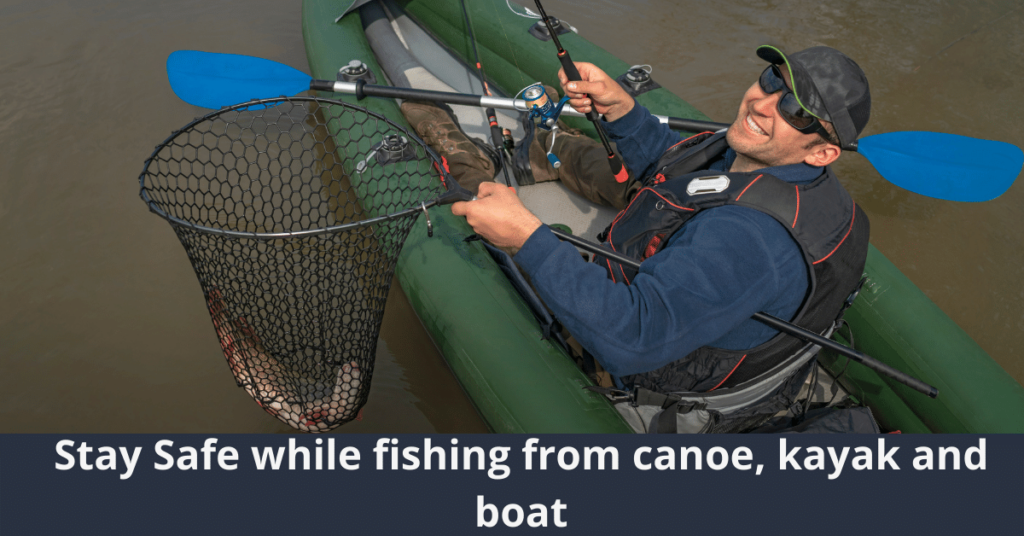







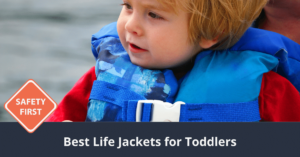

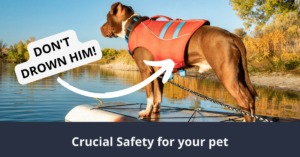
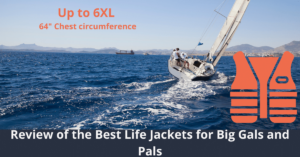
![7 Best Jet Ski Life Jackets with awesome fit [2023 guide] 28 Best Jet Ski Life Jacket](https://insmoothwaters.com/wp-content/uploads/2022/09/Best-Jet-Ski-Life-Jacket-300x157.png)
